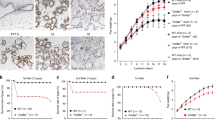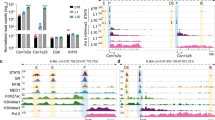Abstract
Adequate lipid secretion by mammary glands during lactation is essential for the survival of mammalian offspring. However, the mechanism governing this process is poorly understood. Here we show that Cidea is expressed at high levels in lactating mammary glands and its deficiency leads to premature pup death as a result of severely reduced milk lipids. Furthermore, the expression of xanthine oxidoreductase (XOR), an essential factor for milk lipid secretion, is markedly lower in Cidea-deficient mammary glands. Conversely, ectopic Cidea expression induces the expression of XOR and enhances lipid secretion in vivo. Unexpectedly, as Cidea has heretofore been thought of as a cytoplasmic protein, we detected it in the nucleus and found it to physically interact with transcription factor CCAAT/enhancer-binding protein β (C/EBPβ) in mammary epithelial cells. We also observed that Cidea induces XOR expression by promoting the association of C/EBPβ onto, and the dissociation of HDAC1 from, the promoter of the Xdh gene encoding XOR. Finally, we found that Fsp27, another CIDE family protein, is detected in the nucleus and interacts with C/EBPβ to regulate expression of a subset of C/EBPβ downstream genes in adipocytes. Thus, Cidea acts as a previously unknown transcriptional coactivator of C/EBPβ in mammary glands to control lipid secretion and pup survival.
This is a preview of subscription content, access via your institution
Access options
Subscribe to this journal
Receive 12 print issues and online access
$209.00 per year
only $17.42 per issue
Buy this article
- Purchase on Springer Link
- Instant access to full article PDF
Prices may be subject to local taxes which are calculated during checkout






Similar content being viewed by others
References
Linzell, J.L. & Peaker, M. Mechanism of milk secretion. Physiol. Rev. 51, 564–597 (1971).
Mather, I.H. & Keenan, T.W. Origin and secretion of milk lipids. J. Mammary Gland Biol. Neoplasia 3, 259–273 (1998).
Smith, S. & Abraham, S. The composition and biosynthesis of milk fat. Adv. Lipid Res. 13, 195–239 (1975).
McManaman, J.L., Palmer, C.A., Wright, R.M. & Neville, M.C. Functional regulation of xanthine oxidoreductase expression and localization in the mouse mammary gland: evidence of a role in lipid secretion. J. Physiol. (Lond.) 545, 567–579 (2002).
Vorbach, C., Scriven, A. & Capecchi, M.R. The housekeeping gene xanthine oxidoreductase is necessary for milk fat droplet enveloping and secretion: gene sharing in the lactating mammary gland. Genes Dev. 16, 3223–3235 (2002).
Ogg, S.L., Weldon, A.K., Dobbie, L., Smith, A.J. & Mather, I.H. Expression of butyrophilin (Btn1a1) in lactating mammary gland is essential for the regulated secretion of milk-lipid droplets. Proc. Natl. Acad. Sci. USA 101, 10084–10089 (2004).
Robenek, H. et al. Butyrophilin controls milk fat globule secretion. Proc. Natl. Acad. Sci. USA 103, 10385–10390 (2006).
Smith, S.J. et al. Obesity resistance and multiple mechanisms of triglyceride synthesis in mice lacking Dgat. Nat. Genet. 25, 87–90 (2000).
Beigneux, A.P. et al. Agpat6–a novel lipid biosynthetic gene required for triacylglycerol production in mammary epithelium. J. Lipid Res. 47, 734–744 (2006).
Boxer, R.B. et al. Isoform-specific requirement for Akt1 in the developmental regulation of cellular metabolism during lactation. Cell Metab. 4, 475–490 (2006).
Cheung, K.J. et al. Xanthine oxidoreductase is a regulator of adipogenesis and PPARγ activity. Cell Metab. 5, 115–128 (2007).
Seymour, K.J. et al. Stress activation of mammary epithelial cell xanthine oxidoreductase is mediated by p38 MAPK and CCAAT/enhancer-binding protein-β. J. Biol. Chem. 281, 8545–8558 (2006).
Seagroves, T.N. et al. C/EBPβ, but not C/EBPα, is essential for ductal morphogenesis, lobuloalveolar proliferation, and functional differentiation in the mouse mammary gland. Genes Dev. 12, 1917–1928 (1998).
Nishino, N. et al. FSP27 contributes to efficient energy storage in murine white adipocytes by promoting the formation of unilocular lipid droplets. J. Clin. Invest. 118, 2808–2821 (2008).
Toh, S.Y. et al. Up-regulation of mitochondrial activity and acquirement of brown adipose tissue-like property in the white adipose tissue of fsp27 deficient mice. PLoS ONE 3, e2890 (2008).
Ye, J. et al. Cideb, an ER- and lipid droplet-associated protein, mediates VLDL lipidation and maturation by interacting with apolipoprotein B. Cell Metab. 9, 177–190 (2009).
Li, J.Z. et al. Cideb regulates diet-induced obesity, liver steatosis, and insulin sensitivity by controlling lipogenesis and fatty acid oxidation. Diabetes 56, 2523–2532 (2007).
Pettersson, A.T. et al. Characterization of the human CIDEA promoter in fat cells. Int. J. Obes. (Lond.) 32, 1380–1387 (2008).
Puri, V. et al. Cidea is associated with lipid droplets and insulin sensitivity in humans. Proc. Natl. Acad. Sci. USA 105, 7833–7838 (2008).
Zhou, Z. et al. Cidea-deficient mice have lean phenotype and are resistant to obesity. Nat. Genet. 35, 49–56 (2003).
Dahlman, I. et al. The CIDEA gene V115F polymorphism is associated with obesity in Swedish subjects. Diabetes 54, 3032–3034 (2005).
Neville, M.C. & Picciano, M.F. Regulation of milk lipid secretion and composition. Annu. Rev. Nutr. 17, 159–183 (1997).
Shekar, P.C. et al. κ-casein-deficient mice fail to lactate. Proc. Natl. Acad. Sci. USA 103, 8000–8005 (2006).
Jeong, J. et al. The PRY/SPRY/B30.2 domain of butyrophilin 1A1 (BTN1A1) binds to xanthine oxidoreductase: implications for the function of BTN1A1 in the mammary gland and other tissues. J. Biol. Chem. 284, 22444–22456 (2009).
McManaman, J.L., Palmer, C.A., Anderson, S., Schwertfeger, K. & Neville, M.C. Regulation of milk lipid formation and secretion in the mouse mammary gland. Adv. Exp. Med. Biol. 554, 263–279 (2004).
Kudo, N. et al. Leptomycin B inhibition of signal-mediated nuclear export by direct binding to CRM1. Exp. Cell Res. 242, 540–547 (1998).
Xu, L., Kang, Y., Col, S. & Massague, J. Smad2 nucleocytoplasmic shuttling by nucleoporins CAN/Nup214 and Nup153 feeds TGFβ signaling complexes in the cytoplasm and nucleus. Mol. Cell 10, 271–282 (2002).
Wiper-Bergeron, N., Wu, D., Pope, L., Schild-Poulter, C. & Hache, R.J. Stimulation of preadipocyte differentiation by steroid through targeting of an HDAC1 complex. EMBO J. 22, 2135–2145 (2003).
Paz-Priel, I., Houng, S., Dooher, J. & Friedman, A.D. C/EBPα and C/EBPα oncoproteins regulate nfkb1 and displace histone deacetylases from NF-κB p50 homodimers to induce NF-κB target genes. Blood 117, 4085–4094 (2011).
Lee, S., Miller, M., Shuman, J.D. & Johnson, P.F. CCAAT/Enhancer-binding protein β DNA binding is auto-inhibited by multiple elements that also mediate association with p300/CREB-binding protein (CBP). J. Biol. Chem. 285, 21399–21410 (2010).
Kouzarides, T. Chromatin modifications and their function. Cell 128, 693–705 (2007).
Borland, G., Bird, R.J., Palmer, T.M. & Yarwood, S.J. Activation of protein kinase Cα by EPAC1 is required for the ERK- and CCAAT/enhancer-binding protein β-dependent induction of the SOCS-3 gene by cyclic AMP in COS1 cells. J. Biol. Chem. 284, 17391–17403 (2009).
Cui, T.X. et al. C/EBPβ mediates growth hormone-regulated expression of multiple target genes. Mol. Endocrinol. 25, 681–693 (2011).
Sahay, B. et al. CD14 signaling restrains chronic inflammation through induction of p38-MAPK/SOCS-dependent tolerance. PLoS Pathog. 5, e1000687 (2009).
Yarwood, S.J., Borland, G., Sands, W.A. & Palmer, T.M. Identification of CCAAT/enhancer-binding proteins as exchange protein activated by cAMP-activated transcription factors that mediate the induction of the SOCS-3 gene. J. Biol. Chem. 283, 6843–6853 (2008).
McCarthy, T.L., Pham, T.H., Knoll, B.I. & Centrella, M. Prostaglandin E2 increases transforming growth factor-β type III receptor expression through CCAAT enhancer-binding protein δ in osteoblasts. Mol. Endocrinol. 21, 2713–2724 (2007).
Dong, J., Tsai-Morris, C.H. & Dufau, M.L. A novel estradiol/estrogen receptor alpha-dependent transcriptional mechanism controls expression of the human prolactin receptor. J. Biol. Chem. 281, 18825–18836 (2006).
Goldhar, A.S., Duan, R., Ginsburg, E. & Vonderhaar, B.K. Progesterone induces expression of the prolactin receptor gene through cooperative action of Sp1 and C/EBP. Mol. Cell. Endocrinol. 335, 148–157 (2011).
Karaya, K. et al. Regulation of Id2 expression by CCAAT/enhancer binding protein β. Nucleic Acids Res. 33, 1924–1934 (2005).
Mori, S., Nishikawa, S.I. & Yokota, Y. Lactation defect in mice lacking the helix-loop-helix inhibitor Id2. EMBO J. 19, 5772–5781 (2000).
Kleinberg, D.L., Feldman, M. & Ruan, W. IGF-I: an essential factor in terminal end bud formation and ductal morphogenesis. J. Mammary Gland Biol. Neoplasia 5, 7–17 (2000).
Wessells, J., Yakar, S. & Johnson, P.F. Critical prosurvival roles for C/EBPβ and insulin-like growth factor I in macrophage tumor cells. Mol. Cell. Biol. 24, 3238–3250 (2004).
Drost, J. et al. BRD7 is a candidate tumour suppressor gene required for p53 function. Nat. Cell Biol. 12, 380–389 (2010).
Gomes, N.P. & Espinosa, J.M. Gene-specific repression of the p53 target gene PUMA via intragenic CTCF-Cohesin binding. Genes Dev. 24, 1022–1034 (2010).
Amir-Zilberstein, L. et al. Differential regulation of NF-κB by elongation factors is determined by core promoter type. Mol. Cell. Biol. 27, 5246–5259 (2007).
Kulyté, A. et al. CIDEA interacts with liver X receptors in white fat cells. FEBS Lett. 585, 744–748 (2011).
Neifert, M.R. Prevention of breastfeeding tragedies. Pediatr. Clin. North Am. 48, 273–297 (2001).
Trotman, L.C. et al. Ubiquitination regulates PTEN nuclear import and tumor suppression. Cell 128, 141–156 (2007).
Ball, R.K., Friis, R.R., Schoenenberger, C.A., Doppler, W. & Groner, B. Prolactin regulation of beta-casein gene expression and of a cytosolic 120-kd protein in a cloned mouse mammary epithelial cell line. EMBO J. 7, 2089–2095 (1988).
Qi, J. et al. Downregulation of AMP-activated protein kinase by Cidea-mediated ubiquitination and degradation in brown adipose tissue. EMBO J. 27, 1537–1548 (2008).
Li, Q. et al. Axin determines cell fate by controlling the p53 activation threshold after DNA damage. Nat. Cell Biol. 11, 1128–1134 (2009).
Acknowledgements
We thank L. Yu, L. Huang, Y. Hong and Y. Zhou for helpful discussions, and B. Groner (Georg-Speyer-Haus Institute for Biomedical Research) for providing HC11 cells. This work was supported by grants from the National Basic Research Program (2007CB914404, 2011CB910800) from the Ministry of Science and Technology of China and the National Natural Science Foundation of China (30925017 and 31030038 to P.L., 90913024 to Y.S.), and from the National University of Singapore and the Singapore National Research Foundation under CRP award no. 2007-04 to M.R.W.
Author information
Authors and Affiliations
Contributions
W.W. devised the hypothesis, designed and performed the experiments, analyzed the data and wrote the first draft of manuscript. N.L., S.Z., J.Z., H.Q. and Y.C. performed the experiments. G.S., M.R.W. performed lipidomics analysis. J.Y. performed EM analysis. Y.X. and Y.S. helped with experimental design and data analysis. P. L. is responsible for the formulation of the hypothesis, experimental design, data coordination, analysis and interpretation. P.L. is also responsible for the writing, revision and finalization of the manuscript as well as for the decision to submit the manuscript for publication. All authors read and approved the final manuscript.
Corresponding author
Ethics declarations
Competing interests
The authors declare no competing financial interests.
Supplementary information
Supplementary Text and Figures
Supplementary Figures 1–8, Supplementary Tables 1–3 and Supplementary Methods (PDF 23506 kb)
Rights and permissions
About this article
Cite this article
Wang, W., Lv, N., Zhang, S. et al. Cidea is an essential transcriptional coactivator regulating mammary gland secretion of milk lipids. Nat Med 18, 235–243 (2012). https://doi.org/10.1038/nm.2614
Received:
Accepted:
Published:
Issue Date:
DOI: https://doi.org/10.1038/nm.2614
This article is cited by
-
Neonatal ketone body elevation regulates postnatal heart development by promoting cardiomyocyte mitochondrial maturation and metabolic reprogramming
Cell Discovery (2022)
-
Lipid and glucose metabolism in white adipocytes: pathways, dysfunction and therapeutics
Nature Reviews Endocrinology (2021)
-
TDP-43 facilitates milk lipid secretion by post-transcriptional regulation of Btn1a1 and Xdh
Nature Communications (2020)
-
PGC-1α induced browning promotes involution and inhibits lactation in mammary glands
Cellular and Molecular Life Sciences (2019)
-
Tip60-mediated lipin 1 acetylation and ER translocation determine triacylglycerol synthesis rate
Nature Communications (2018)



